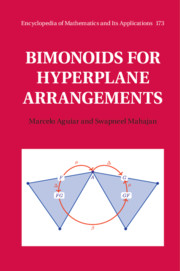Book contents
- Frontmatter
- Contents
- Preface
- Introduction
- Part I Species and operads
- Part II Basic theory of bimonoids
- Chapter 5 Primitive filtrations and decomposable filtrations
- Chapter 6 Universal constructions
- Chapter 7 Examples of bimonoids
- Chapter 8 Hadamard product
- Chapter 9 Exponential and logarithm
- Chapter 10 Characteristic operations
- Chapter 11 Modules over monoid algebras and bimonoids in species
- Chapter 12 Antipode
- Part III Structure theory for bimonoids
- Appendices
- References
- List of Notations
- List of Tables
- Author Index
- Subject Index
Chapter 9 - Exponential and logarithm
from Part II - Basic theory of bimonoids
Published online by Cambridge University Press: 28 February 2020
- Frontmatter
- Contents
- Preface
- Introduction
- Part I Species and operads
- Part II Basic theory of bimonoids
- Chapter 5 Primitive filtrations and decomposable filtrations
- Chapter 6 Universal constructions
- Chapter 7 Examples of bimonoids
- Chapter 8 Hadamard product
- Chapter 9 Exponential and logarithm
- Chapter 10 Characteristic operations
- Chapter 11 Modules over monoid algebras and bimonoids in species
- Chapter 12 Antipode
- Part III Structure theory for bimonoids
- Appendices
- References
- List of Notations
- List of Tables
- Author Index
- Subject Index
Summary
The lune-incidence algebra (of a hyperplane arrangement) acts on the space of all maps from a comonoid to a monoid. In particular, any noncommutative zeta function defines an invertible operator on this space. We call such an operator an exponential. The inverse operator is given by a noncommutative Möbius function and we call it a logarithm. Given a cocommutative comonoid and a bimonoid, any mutually inverse pair of exponential and logarithm sets up inverse bijections between coderivations and comonoid morphisms from the comonoid to the bimonoid. Dually, for a bimonoid and a commutative monoid, there are bijections between derivations and monoid morphisms from the bimonoid to the monoid. As a consequence, any logarithm of the identity map on a bimonoid maps into its primitive part when it is cocommutative, and factors through its indecomposable part when it is commutative. This story has a commutative counterpart with the lune-incidence algebra replaced by the flat-incidence algebra. This can either be deduced from the above via the base-case map or can also be developed independently. In this case, the exponential and logarithm are uniquely defined using the zeta function and Möbius function of the poset of flats. There is a parallel theory for q-bimonoids for q not a root of unity. It employs the two-sided q-zeta function and two-sided q-Möbius function. These are elements of the bilune-incidence algebra. Exp-log correspondences can also be developed using the notion of series of a species. For a comonoid, one can further define primitive series and group-like series. The lune-incidence algebra acts on the space of series of a monoid, and any mutually inverse pair of a noncommutative zeta function and noncommutative Möbius function defines inverse operations onthis space. For the exponential bimonoid, this recovers Möbius inversion in the poset of flats, while for the bimonoid of chambers, this yields a noncommutative version of Möbius inversion. Moreover, for any bimonoid, the exp-log correspondences set up a bijection between its primitive series and group-like series. The passage from this approach to the previous approach involves the convolution monoid, the bimonoid of star families, and the universal measuring comonoid. The classical setting is as follows. The space of formal power series (viewed as a monoid under substitution) acts on the space of series of a Joyal monoid. The usual exponential and logarithmic power series yield the exp-log correspondence on it. This classical picture relates to the one for monoids in species relative to any braid arrangement. More precisely, the action of the exponential and logarithmic power series corresponds to that of the uniform noncommutative zeta function and its inverse noncommutative Möbius function.
Keywords
Information
- Type
- Chapter
- Information
- Bimonoids for Hyperplane Arrangements , pp. 384 - 441Publisher: Cambridge University PressPrint publication year: 2020
